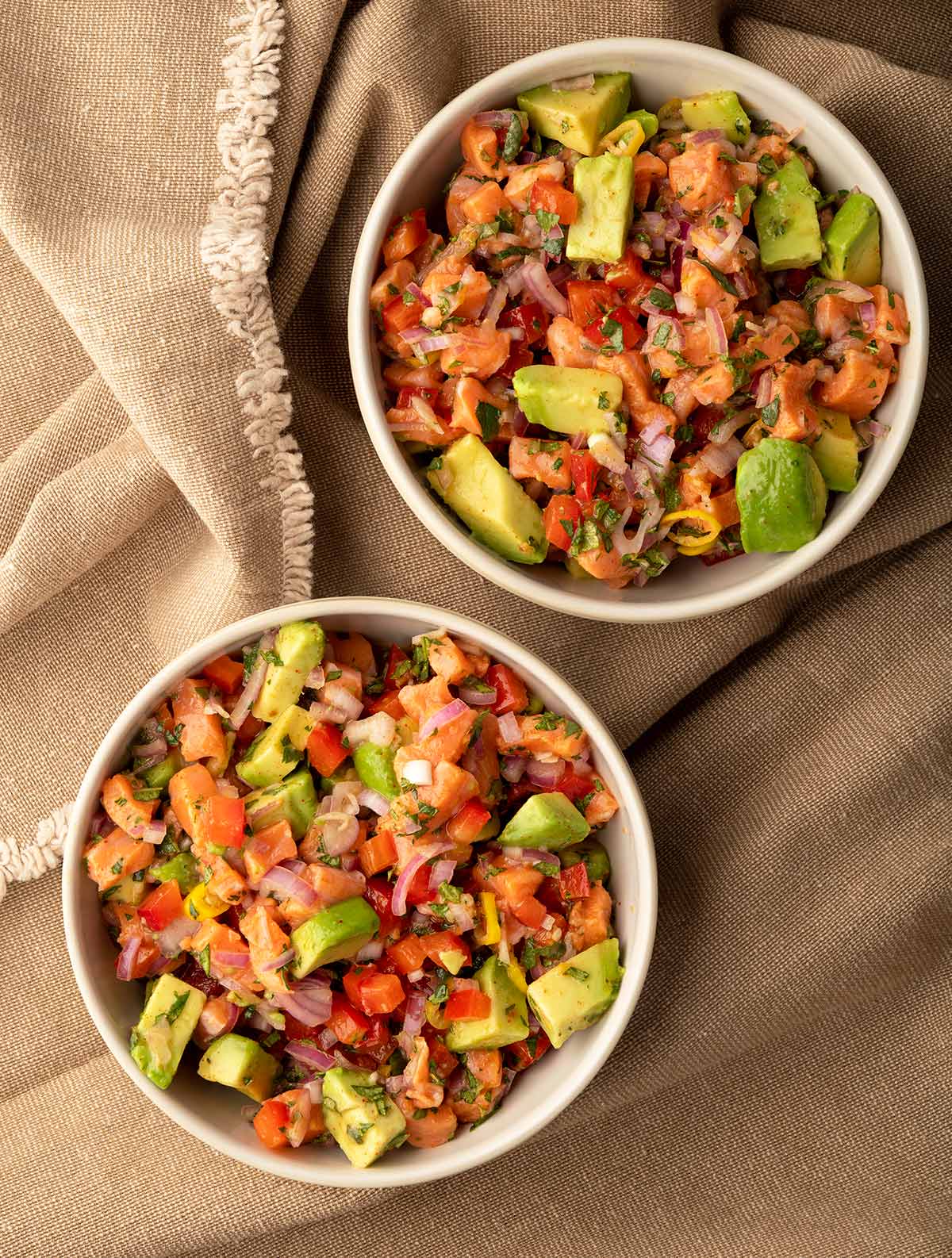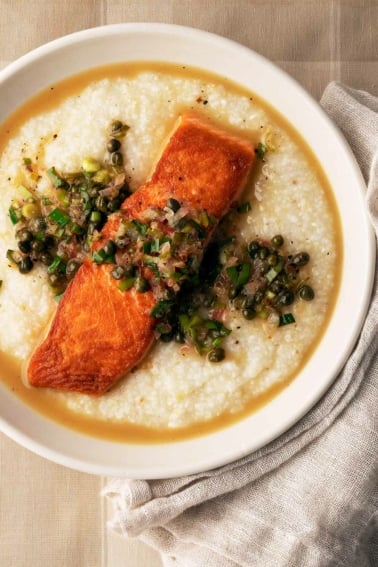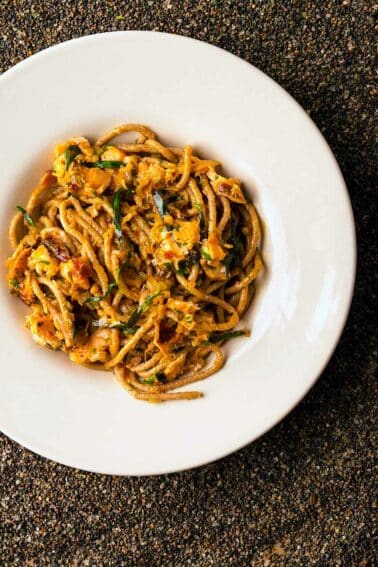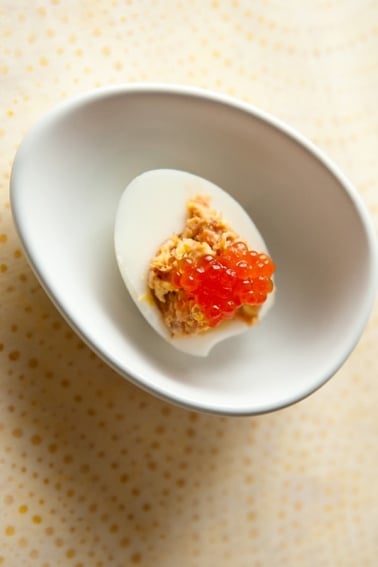As an Amazon Associate I earn from qualifying purchases.
Salmon ceviche is one of the many variations on ceviche you can find in Chile; after all, they farm salmon there.
Chile, like its neighbor Peru, is one of the many places that claim ownership of ceviche, and without a doubt the dish is varied and excellent there. And while ceviche varies from cook to cook, and region to region, ceviche Chileno tends to be cut small, almost like a tartare.

To be sure, this is a salmon ceviche recipe inspired by Chilean ceviches that I designed after reading a few dozen recipes from Chile in English and in Spanish. It tastes amazing, and is very different from my recipe for Mexican tostadas de ceviche, as well as my recipe for a simple, basic ceviche.
That last recipe is important, as it also includes a discussion on food safety, which you have to care about if you want to safely eat salmon ceviche. Why? Raw, never frozen salmon — at least wild salmon — can carry anisakis worm larvae, which will make you sick. It is very rare, but it’s not impossible. If you don’t feel like reading the whole discussion, the short version is that you need to freeze salmon for a week or more at -4°F or colder before eating it raw.
I always use wild salmon for my ceviche, not only because, well, this is a wild foods website, but also because I catch a lot of king salmon here in California — and I occasionally fish all species of Pacific salmon commercially up in Alaska.

There are a few decent salmon farms on this planet, but you will have to do your research. Most farmed salmon is pretty horrendous for the environment. And if you don’t have access to good salmon, most other fish will do, so long as they are pre-frozen first for safety.
Back to the ceviche.
What makes this ceviche different from many others is the presence of spices. In Chile, there is a spice mix called merken that is a mixture of smoked peppers, coriander and salt, sometimes with cumin, too. I added those elements to this ceviche.
I also used huacatay instead of cilantro here because it is a common herb used in that part of the world, and, well, I happen to be growing it. Just use cilantro if you don’t happen to have this odd herb lying around.
The result is smoky, bright, crunchy and silky. Definitely worth your time.
Salmon Ceviche
Ingredients
- 1 red onion, minced
- 1 Lemon, juiced
- 1/2 cup lime juice
- 1 grapefruit, juiced
- 1 pound salmon, diced small
- 1 clove garlic, minced
- 1 sweet bell pepper, diced
- 1 avocado, diced
- 1/4 teaspoon ground cumin
- 1/4 teaspoon ground coriander
- 1/2 teaspoon smoked paprika (use regular paprika if you can't find smoked)
- 1/2 cup chopped cilantro or huacatay
- Salt to taste
Instructions
- Mix all the citrus juice in a bowl and add the minced onion. Let this sit while you chop all the other ingredients.
- Add each ingredient to the bowl when you finish chopping it, leaving the cilantro for last. Mix well, and either eat right away, or refrigerate for up to 30 minutes before serving.
Notes
Nutrition
Nutrition information is automatically calculated, so should only be used as an approximation.





Hi Hank, can this recipe be made with rainbow trout instead of salmon? I have several Sierra lake trout (ie hatchery trout) I would like to make cerviche with. Thanks,
k
Kurt: only if you freeze it for a week first.
We loved it. Perfect for lunch on these hot days. Thanks so much, Hank!
Hi Hank,
This looks awesome, I’ll definitely be making it later this week. One question, what do you usually serve it with? Does it work better as an appetizer with something like tacos as the main course, or can it be the centerpiece if it gets a little backup from some side dishes?
Dan: I like it on tostadas, but even saltines are a good addition. Or go no-carb and just eat a big bowl if it!
Sushi chefs often serve many species of fish completely raw and they are trained to spot the Anisakis worms and remove them before serving the fish to customers. They are visible to the eye. For some species fish and areas where they are caught, Anisakis is a fact of life. But it is possible to have such a degree of Anisakis infection that the fish can’t be served raw and must be cooked or frozen. There are some good YouTube videos of sushi restos and the chefs that prepare the raw fish and how they go about prepping the raw fish prior to placing it in front of customers for serving later in the evening. One Brooklyn sushi bar’s specialty is local unknown fish from the Atlantic coastal areas and they state that the Anisakis is out of control but can be dealt with, even raw. Of course freezing solves the problem but you are still eating the worms albeit dead.
David: At least in the United States, by law sushi restaurants must use pre-frozen fish. That is not always followed. And no, you cannot see the larvae of the anisakis worm; only the adult worms are visible. You are correct that sushi chefs delicately cut them out — I did, too, when I worked at a fish restaurant. We used a light box to reveal them. You are also right in that some fish have so many worms they are unsaleable, but that is rare. I have seen that, and it’s nasty!
Ceviche has always been a favorite of mine, going all the way back to 1952 when I had my first in the El Panama Hotel, then the newest and largest building in the Republic. Today. if it still stands, it must appear an outhouse compared to all the new construction around it.
In those days, indeed up until relatively recently, avocado was not included in the recipe, though it is a natural complement to spiciness of the dish. To me it is a welcome addition.
I remember reading in Gourmet Magazine years ago that really good ceviche chefs were in such high demand that an international conflict was barely avoided when the wife of an ambassador stole the chef of the embassy of another and not friendly country
Hi Hank! Thanks for this variant of ceviche! Looks great. Question: where did you get your huacatay seed or starts? I have been growing and using Mexican marigold as a substitute (which is not bad at all) but I miss the distinct flavor of huacatay (having living in Peru here and there for many years). Thanks!
Gary: I can’t remember, but they are available online at Etsy, and I think Sow Exotic sells starts, too. I grew some from seed as well. I think you can find it with a Google search.
Our family is from Ecuador. Our ceviche/cebiche is very different from other SA countries – mainly, no peppers at all! We make a separate “ahi” sauce that one can add upon being served.
Elizabeth: Very cool! What goes into the ceviche itself then? Fish, citrus, onions, and what else?
I can`t have grapefruit due to hyper tension, is there a substitute.
Low: You bet. Just use other citrus, like lemons, oranges or more lime.
Thank you for the tip about freezing the fish first. I’ve only made it with precooked shrimp.
Perfect timing! Just heading to the dock to fish Buoy 10!